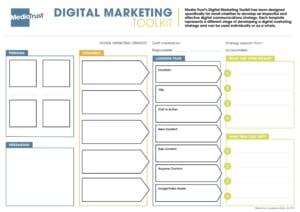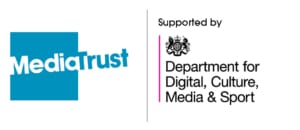5 tips to get the most out of pro bono volunteers
Unlock the full potential of skilled volunteers with a few simple strategies
Posted 6 November 2025

The Digital Marketing Strategy Template will help you think through your digital marketing and communications activity in a more planned way.
Below is a step-by-step guide to completing the template for your charity. We’ve also provided an example from a small arts charity called Trajectory Theatre, so you can see what your completed template should look like.

If the download is not working please ensure you disable your ad blocker or try a different browser.
Time: 1-2 hours (depending on size and complexity of the organisation).
Resources: Print-outs or digital copies of the template; biros and coloured pens; post-it notes; Persona templates (could be completed in advance).
Team: We suggest working with at least one other member of your team to populate the template. If that is not possible completing them yourself is perfectly fine.
Responsible: The person who will be carrying out the majority of the digital marketing activity and coordinating other staff and volunteers to contribute content for digital channels.
Accountable: A senior staff member or trustee who will ‘sponsor’ digital marketing activity and support the responsible person, receiving reports on progress to ensure things stay on track.
Persona: Your audiences should be at the heart of your digital marketing. Use the Persona Template to develop an understanding of your different audience groups.
Messaging: A busy charity will have many messages to communicate. List a maximum of your five most important messages in order of priority. Think about what you want people to think, feel, say and do about your organisation. You may choose to link certain message with a certain audience.
Channels: You can think about three different types of channels:
Review what’s already working and what could be improved. If one of your audience groups has a preference for a channel you don’t currently use, you could think about starting a presence there. You can restrict content on a particular channel to one audience group or engage multiple audiences through the same channel.
Landing Page: The landing page section helps you plan one landing page, but you can use this format to plan others. Plan the website destination for your priority message or campaign. Send people here from social media, email and any digital advertising. As you will have multiple landing pages for different campaigns and events over the year, you can use this format again to plan important new pages on your website.
How will you measure?: Digital marketing channels will give you plenty of data on how your content is performing. Start with the basic measurement tools, e.g. Google Analytics, Facebook Insights and the stats from your email marketing system (e.g. Mailchimp).
What are your goals?: Your measurement tools will help you see whether you’re on track to meet your digital marketing goals. Our Digital Objective Builder will help you set targets.
What will you test?: Digital is great for testing and learning about your audiences and what types of content and communication work for them.
Budget: If you find in-kind support through one of your corporate partners, register for the Google Ad Grants programme, or set aside a small budget to test out Facebook Advertising, you can record it here.
Risks and Mitigations: There are risks associated with any plan, or new way of working. What things do you need to bear in mind when delivering on your strategy? What actions could help to mitigate the risks?
Recommended further reading:
Lloyd’s UK Business and Charity Digital Index
More information about content strategy
Youtube’s Hero, Hub, Help model
Find out about Google Ad Grants — free budget for advertising on Google search results pages for registered charities.
You can also check out our Digital Leadership Stories five-part film series, which offers you an inside look into small charities that are leading the way in digital. Each film explores a key area of digital communications and provides unique advice and learning from digital leaders working across the sector.

Unlock the full potential of skilled volunteers with a few simple strategies
Posted 6 November 2025

How can your charity get better results from AI without extra budget? By mastering great prompts.
Posted 22 September 2025

A dive into how early-career creatives can use AI effectively and responsibly AI is undeniably transforming the creative and media landscape. For many early-career creatives, this can feel intimidating. But if used correctly, AI can...
Posted 22 September 2025
